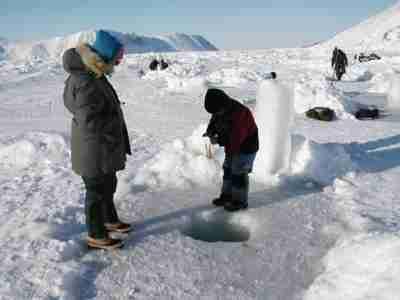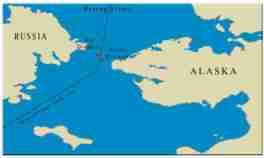
|
|
1 March, 2002
What is a social scientist? And, what methods do socio-cultural
anthropologists use to conduct their research?

Photo of Carol and Edward Soolook AKA Oomiam.
The very ways in which human beings connect themselves to the land that they live on and rely on, is important. She, like other anthropologists, believes that one of the most important ways to understand how humans live is to share that experience with them in some way. This process is very personal and involves a great deal more than simply being in the community, handing out questionnaires, or just gathering facts. Instead she, and other socio-cultural anthropologists, place an importance on actually parcticipating with people in the community and listening to what people have to say about themselves and their lives. It is not just observing what people do, or looking at the tools and products that a culture produces or leaves behind. This method of "parcticipant observation" is among the most important that anthropologists use.
A large and integral part of this research project involves collecting and recording oral histories and life histories. The focus is on gathering and documenting information that relates to subsistence and the traditions that support it, as well as noting changes that have taken place across the generations. It's important to note that here in Diomede, as in other places around the world, communication and transportation have created a smaller world. For example, electricity came to the island in the 1970's bringing television, phones, and computers with it. The world is becoming increasingly more interdependent as a result of globalization and modernization.
One of Carol's goals for this project is "the mutual benefit of the researcher, scientific world, and the community whose ways of life is the subject of the study."

Dr. Carol Zane Jolles (pronounced ya-les) is a socio-cultural anthropologist. As the head of this three year study, Carol is called the PI, or Principal Investigator, and the research project is called, Change and it's Impact on Culture, Economy and Identity in Three North Bering Strait Alaskan Inupiat Communities. I will be working with Carol during this, the first field visit of the three year project, as she begins to look at and document the ways in which the contemporary Inupiat Eskimo of three communities (Diomede, Wales, and King Island) learn about and pass on knowledge about the subsistence way of life that enables them to remain in this isolated arctic region.
Carol describes anthropologists as "social scientists who study humans, including how human beings live in many different environments." She, like scientists who work in other subject areas in the field of science, collects and analyzes information that helps us understand more about our world and how we interact with it. As an anthropologist, Carol's interest and work involves learning about people's lives, experiences, histories, etc. She has a parcticular interest in Arctic island communities and has been working in the North Bering Strait communities since 1987. She notes that, "what other scientists call 'data' is often the detailed story of a person's life" from which information about human history allows her to "understand what people do in special situations, like living in the Arctic."

Photo of Carol out on the ice, learning about subsistence crabbing with local kids.
Coming to Diomede this time is the first fieldtrip of the project, which will last three years. Although Carol has worked with people from Diomede before, it's very important to meet with the community members, build relationships, and make sure that people are comfortable with the research process. This is especially important because a lot of the research involves conducting personal interviews that are recorded, transcribed, and shared with this community as well as others in Alaska and elsewhere. In fact, one of our first jobs is to distribute bound notebooks containing some of the interviews that Carol previously recorded with elders.
Over the next three years, Carol and her fellow researchers will make several trips and continue to collect and record personal interviews as well as maps, diagrams, photos, and any other material(s) that can help document information and history that relates to subsistence, the traditions that support it, and some of the changes that are taking place. One consequence of these changes is that this small, arctic community is less isolated. This work on Little Diomede would not have been possible without the formal written permission of the Indian Reorganization Act Council of Native Village of Diomede (IRA).
For more details at this time, please refer to the project description on my web page.

Photo: Map of Little Diomede, Alaska and Big Diomede, Russia. The island of Little Diomede sits in the Bering Strait, with the village of Ingaliq facing West towards Big Diomede. Between the two islands is the water boundary that separates Russia and the United States. Even though Big Diomede was once home to families living on Little Diomede and played an important role in subsistence, the residents of the village, as US citizens, have not had permission to cross over to big Diomede since the cold war began. On the US side of the International Date Line and boundary it is today, while on the other side it is not only another country, but another day. It's important to note that while we are right across from both the International Date Line, and from Russia, all three of the communities in this project are in Alaska, and are part of the United States.
Contact the TEA in the field at
.
If you cannot connect through your browser, copy the
TEA's e-mail address in the "To:" line of
your favorite e-mail package.
|
